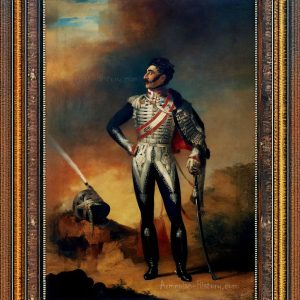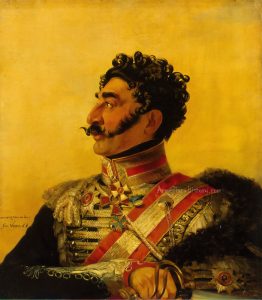(Ռոստոմ Մադաթյան, Rostom Madatyan)
Prince Valerian Grigoryevich Madatov, originally named Rostom Madatyan, was born in 1782 in the village of Avetaranots, located in the historical region of Artsakh (Karabakh). He hailed from a prominent Armenian noble family. His life and career were marked by remarkable achievements, making him one of the most notable Armenian military figures in the Russian Empire.
Early Life and Military Beginnings
Madatov’s early years were shaped by the tumultuous political landscape of the Caucasus. At the age of 15, he left his native land for Saint Petersburg, the capital of the Russian Empire, to pursue a military career. His decision to join the Russian army was a significant turning point, aligning his fate with the Empire’s interests in the Caucasus and beyond.
Military Achievements
Madatov quickly distinguished himself as a capable and courageous officer. He participated in numerous military campaigns, including the Russo-Persian Wars and the Napoleonic Wars, showcasing his strategic acumen and bravery. His role in these wars earned him rapid promotions, and he became known for his exceptional leadership skills.
During the Russo-Persian War of 1804-1813, Madatov played a crucial role in securing Russian victories, contributing to the Treaty of Gulistan, which ceded several Armenian territories to Russia. His leadership in the Caucasian campaigns further solidified his reputation as a formidable military commander.

Role in the Napoleonic Wars
Madatov also served with distinction during the Napoleonic Wars. He was actively involved in the Battle of Borodino and the subsequent campaign that led to the defeat of Napoleon’s forces in 1812. His contributions were instrumental in protecting Russian territories and ensuring the stability of the Empire during this critical period.

Governance and Later Years
In recognition of his military service, Madatov was appointed as the governor of Dagestan, a volatile region in the Caucasus. His tenure as governor was marked by efforts to maintain order and stability in the region. He was known for his diplomatic approach, balancing the complex relations between the local tribes and the Russian administration.
Madatov’s career was not without challenges. The Caucasus region was fraught with conflict, and he often found himself navigating the delicate balance between military action and diplomacy. His ability to manage these challenges further cemented his legacy as an effective leader.
Legacy and Death
Prince Valerian Madatov passed away in 1829, but his legacy endures in Armenian and Russian history. He is remembered not only as a military leader but also as a symbol of Armenian resilience and contribution to the Russian Empire’s military and political landscape. His life is a testament to the role of Armenian nobles in shaping the region’s history, particularly in the context of Russian expansion into the Caucasus.
Madatov’s portrait by George Dawe, exhibited in the Military Gallery of the Winter Palace in St. Petersburg, and his contributions to the military history of the Russian Empire are still celebrated today. His story reflects the complex interplay of loyalty, identity, and service in a period of significant geopolitical change.
Prince Valerian Grigoryevich Madatov’s life and career exemplify the rich and intertwined histories of Armenia and Russia. As a military leader, diplomat, and nobleman, his legacy continues to inspire and inform our understanding of the region’s history. His achievements are a testament to the enduring spirit and resilience of the Armenian people, and his story is an integral part of the broader narrative of Armenian contributions to world history.

